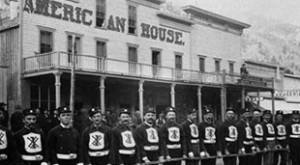Permanent collection
The Telluride Historical Museum’s permanent galleries explore:
Telluride’s Geological Past
“This high, aloof region was born in the log prehistoric millennia when the earth’s frame heaved and shifted and belched forth fire.”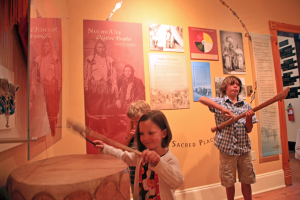
In the museum’s Origins Room, explore how earth forces carved the San Juan mountain range over 65 million years ago and see samples of the flora and fauna native to this beautiful and remote geography. Learn more about how ice, fire, snow, water, and wind combined to erode the old uplifted seabed and its volcanic cover to create Telluride’s majestic scenery.
These immense geological forces created conditions of opportunity and risk for generations of Ute Indians (called “Nuchu,” or “the people”), prospectors, miners, entrepreneurs, artists, and recreation enthusiasts.
The Telluride Blanket 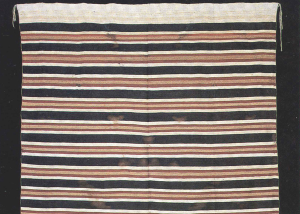
The story of the Telluride Blanket continues to mystify, intrigue, and inspire. The only fully intact example of a brown/red/white twill fabric from the Ancestral Puebloan peoples, or Anasazi, the Telluride Blanket has been radiocarbon dated to have been made between 1041-1272 C.E. Learn more about how the blanket’s original location was re-discovered and why it now calls Telluride its home.
Read more:
Sagstetter, Beth & Bill (2008). Unraveling the Mysteries of the Telluride Blanket, BenchMark Publishing: Denver.
Unraveling the Mysteries of the Telluride Blanket
Nuchu/Ute Native Peoples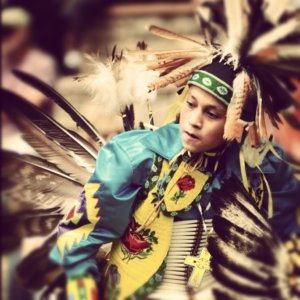
“In the beginning there was nothing but the blue sky, clouds, sunshine, and rain.” – Nuchu Creation Story, shown at Ute Indian Museum, Montrose, Colorado
The Nuchu called the San Juan Mountains “Shining Mountains.” These mountains were the center of their universe. Traditional Nuchu culture reflects 10,000 years of successful adaptation to the mountains and surrounding valleys, plateaus, and basins.
Learn more about the history of the valley’s first inhabitants. Listen as the Nuchu tell a creation story and see artifacts from modern Nuchu life. Interact with the sounds of Nuchu tradition by playing a traditional drum and flute.
From Mining Camp to Community
In the 1870s, a diverse group of prospectors, settlers, and entrepreneurs sought opportunity in this rich mountain valley. Transportation and building materials were primitive and supplies were scarce and expensive. Yet by the 1880s, the primitive mining camp, with its muddy streets and random layout, evolved into a thriving community of buildings and businesses, where everything existed to support the mines.
Explore the early streets of Telluride and learn more about the people who helped build a town for mining in the remote valley in the San Juans.
Community Life 
Explore the daily life of Telluride’s families in the late nineteenth and early twentieth centuries – in town and up in the mining camps of Tomboy and Marshall Basin. Learn more about Telluride’s most famous resident, Harriet Backus, and her amusing and often challenging experiences living in Telluride’s most remote community.
Telluride at Leisure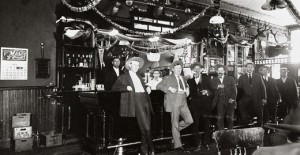
In the late nineteenth century, tax income from Telluride’s red-light district contributed to the town’s financial infrastructure. Explore the stories of the women who “worked the line,” and see artifacts from Telluride’s other “gentlemanly pastimes” in this unique and colorful exhibit.
Health and Hardships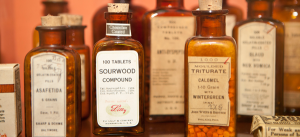
Originally built as Hall’s Hospital in 1896, the Telluride Historical Museum displays a fascinating range of artifacts from when the hospital served miners and their families in Telluride. Learn more about the health of Telluride’s miners and their families between, including the despair and hope they felt struggling against the brutal and beautiful landscape of the San Juans.
The Miners
 The ores of the San Juan miners were of good grade, but generally diverse and complete in character – their successful treatment required a great deal of metallurgical skill.” – W.H. Storms, “Mining in the San Juans,” 1911.
The ores of the San Juan miners were of good grade, but generally diverse and complete in character – their successful treatment required a great deal of metallurgical skill.” – W.H. Storms, “Mining in the San Juans,” 1911.
Mining the San Juans for mineral-rich ore was a backbreaking, dangerous, and costly enterprise. Learn more about how engineers and miners tackled the often complex mining and milling process to extract the gold, silver, and zinc that lay below. Artifacts in this exhibit include geological samples native to the San Juan Mountains, information about the assaying process and hard rock mining equipment.
Otto Mears: The Pathfinder of the San Juans
The Russian-born Otto Mears is remembered by history in many different ways: a soldier, farmer, freighter, miner, merchant, and even as a politician. But to the settlers of Colorado, the name of Mears was synonymous with toll roads and railroads. He built them both, in mountainous regions believed to be too remote and dangerous. His ambition and accomplishments in helping to make the San Juan mountain ranges accessible to travelers and commerce earned him the title, “The Pathfinder of the San Juans.”
Goodbye Boom, Hello Quiet
Throughout the 1920s, the Great Depression caused demand for lead, copper, zinc, silver, and gold to plummet. Consequently, Telluride’s “boom” years as a town supporting a robust mining industry came to a close. Listen to oral histories from the people who grew up in Telluride during Telluride’s “quiet years,” and learn more about what kept Telluride’s community together when the local economy crashed.
Telluride Reborn
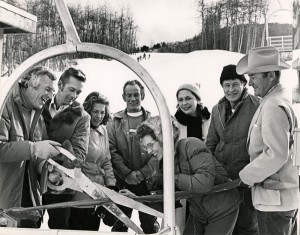 “We are really the ‘last frontier’ in the U.S. Few have discovered the beauties and the delights of vacationing and living here. But the time is not far off when everything will be changed. Whether you have mixed feelings or not about a changed Telluride, it’s bound to come.” – Editorial, The Telluride Times, 1967.
“We are really the ‘last frontier’ in the U.S. Few have discovered the beauties and the delights of vacationing and living here. But the time is not far off when everything will be changed. Whether you have mixed feelings or not about a changed Telluride, it’s bound to come.” – Editorial, The Telluride Times, 1967.
In 1961, Telluride was designated a National Historic Landmark District by the U.S. Department of the Interior, a designation that was to shape the character and rebirth of Telluride in the late twentieth century. Listen to the stories of locals and visitors alike as you learn how Telluride grew into a summer festival and winter ski retreat – all while maintaining its historic character and charm.
Hard Rocks, Rough Lives 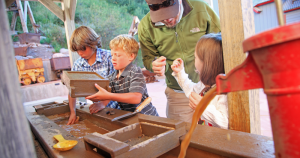
Completed in 2011, the Museum’s outdoor exhibit and education area is an interactive experience of the technology and logistics of hard rock mining in the San Juans. Go inside the exhibit’s Bullion Tunnel and learn how miners blasted rock! Learn how the jog-back tram system transformed transportation of ore to the mills below! Don’t forget to try your luck with the sluice – you might just discover your own riches!


